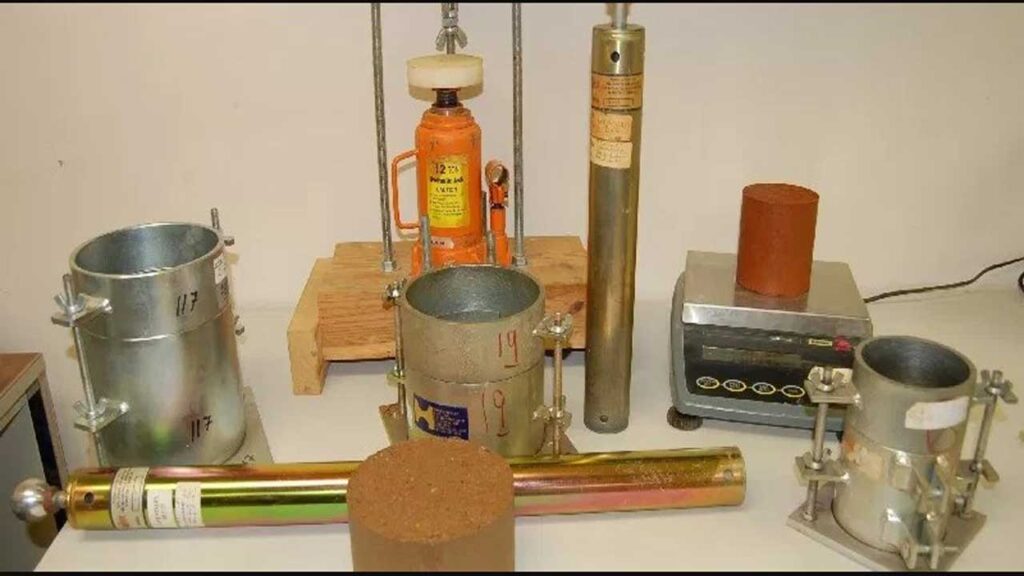
Ralph Roscoe Proctor was an army engineer in the US during the 1st world war. Proctor’s interest in geotechnical engineering began during his undergraduate studies at the University of California, Berkeley. In the early 1930s, he finally created a solution for determining the “maximum” density of soils. Specifically, in 1933 Proctor showed that the dry density of a soil for a given compactive effort depends on the amount of water the soil contains during soil compaction. His original test is most commonly referred to as the standard Proctor compaction test; his test was later updated to create the modified Proctor compaction test.
These laboratory tests generally consist of compacting soil at a known moisture content in a cylindrical mold with a collar of standard dimensions of height and diameter using a compactive effort of a controlled magnitude. The soil is usually compacted into the mold to a certain number of equal layers, each receiving a number of blows from a standard weighted hammer at a specified height. This process is then repeated for various moisture contents and the dry densities are determined for each. The graphical relationship of the dry density to moisture content is then plotted to establish the compaction curve. The maximum dry density is obtained from the peak point of the compaction curve and its corresponding moisture content, known as the optimal moisture content (Source: Wikipedia, Proctor compaction test).
So why are there two different Proctor tests? There are actually a couple of answers to that. The first answer is that mobile equipment grew larger after the standard Proctor test was developed, and the second answer is clay. Let’s explore further.
In the closing phases of World War 2, and into the 1950s, heavier loads from larger airplanes and heavier truck traffic were imparting more distress on asphalts and soil subgrades. Once in a while the compacted soils failed with these higher loads when they were designed based the standard Proctor. In short, densities were too low and moisture too high for these higher loads. To solve the issue of needing to design for higher loads, the modified Proctor test was presented by ASTM in 1958 (source: https://www.jetir.org/papers/JETIR2105014.pdf).
So, what about clay? With respect to compaction, the selection of the test method should depend on whether the clay is for structural fill of if it’s to provide a low permeability zone. If it’s for the latter, the answer is clear. You should use the standard Proctor test. Why? Well for clay, if the platelets can be better aligned, becoming parallel to each other, then the permeability will be lower. Don’t get me started on the diffuse double layer, but let’s just leave it at that for the moment. For the standard Proctor, with its higher moisture content, you can get the test sample deforming against itself under the impact of the Proctor hammer, especially when compacting wet of optimum. Think sheepsfoot compactor. All those feet on the roller do much the same as the Proctor hammer. So, if you want the clay to have a lower permeability, specify the standard Proctor and compact it in the field wet of optimum.
If, on the other hand, the clay is to perform as a structural fill, you probably want the material to have a higher shear strength. If so, you ought to use the modified Proctor test.


Comments (2)
Ray Wood
September 22, 2023 at 1:17 pmBryan – the Proctor developed his tests to simulate two specific rollers in use in the 30s, 40s and 50s. We no longer use such rollers in modern industry. Whilst the Modified Proctor test approximates to the CAT825 roller, this is not such a commonly used compactor. More commonly used compactors such as the CAT815 or CAT56 or their equivalents have compaction curves that lie between Standard and Modified test results. Therefore, the industry no longer has a lab test that simulates field conditions for this equipment. This leads to many inadvertent issues when using these laboratory tests to develop compaction criteria, not least of which clays are often significantly dry of optimum in the compacted state, when the specifier believes the material is compacted wet of optimum. Compacting a clay soil inadvertently dry of optimum will result in higher volume change and loss of strength/stiffness on future wetting. If the industry were to move away from thinking of wet/dry of optimum in terms of moisture content to thinking of it in terms of air content (see International Levee Design Handbook and UK Highways Dept specifications) much of the misbehaviour of compacted cohesive fills would be eliminated. Also a proper understanding of wet/dry of optimum states (in terms of air content) allows clays with higher plasticities to be used as suitable fills and allows contractors to be given wider placement moisture content windows to work with. This can lead to considerable cost savings for earthen construction by reducing haul away/haul in costs and minimising/eliminating moisture conditioning. These learnings from the field of civil engineering earthworks construction could have implications for the compaction of filtered tailings. I believe more research is needed on the long term behaviour of filtered tailings on wetting during their lifetime to develop appropriate compaction criteria. Cutting and pasting civil engineering specifications into the mining industry will likely result in cost inefficiencies or worse! Happy to elaborate further next time we meet, possibly Vancouver?
admin
September 22, 2023 at 11:57 pmWhat a wonderful and thoughtful comment, Ray! Would you mind also posting this on the LinkedIn page? I think a lot of people could learn from it.
Unfortunately I won’t be at T&MW this year.
We need to get the lab testing conversation going again soon. Del Fredlund has a lot of good advice on unsaturated triaxial shear testing in his book.
Comments are closed.